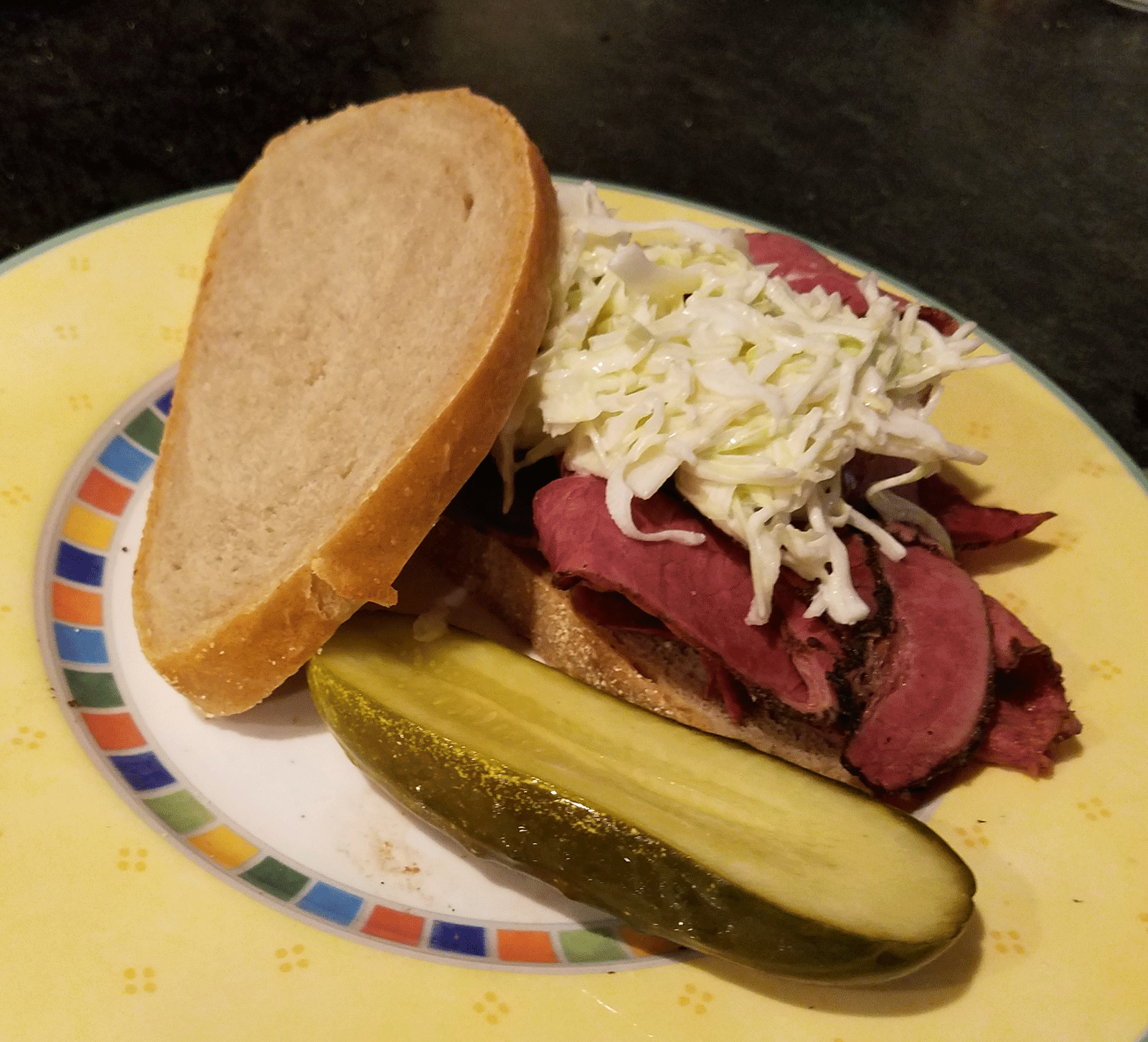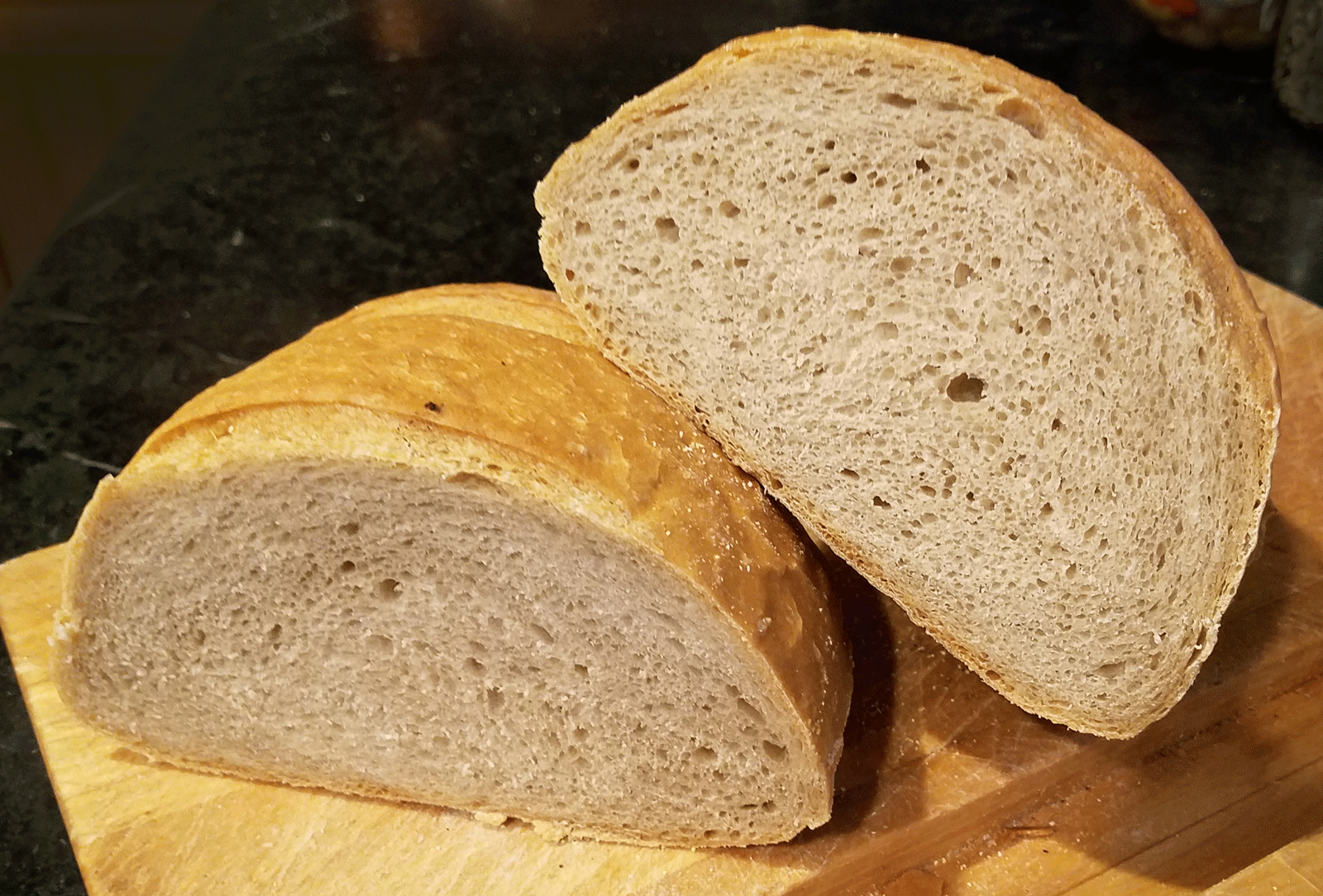| Rye %: | 40% |
| Stages: | 2-Stage quick sponge, Final dough |
| Leaven: | Rye sour culture, Instant yeast |
| Start to Finish: | 7-8 hours |
| Hands-on Time: | 30-40 minutes |
| Yield: | Two 1½ lb/700 g loaves |
Deli rye – that light, open-crumbed, caraway-fragrant New York classic – is what most Americans think of when they hear “rye bread.” Without getting into the rightness or wrongness of that fact, deli rye is without question the bread to wrap around a thick layer of pastrami, corned beef or pickled tongue – with or without Swiss cheese, cole slaw, sauerkraut, mustard and/or Russian dressing. So when my wife went shopping one morning and came back with a package of heavily peppered, deep pink pastrami, there was no question about how we were going to eat it.
Problem was, we didn’t have any deli rye on hand, and I’m enough of a rye snob so that I refuse under any circumstances to buy the plastic-wrapped stuff they sell in the supermarket. I did, however, have a stock of white rye and first clear flour, as well as a robust rye sour culture I’d fed the night before. Still, my standard deli rye, which uses a tw0-stange sponge in addition to the final dough, is normally a two-day affair and we wanted our pastrami-on-rye that evening?
The thought hit me like a flash of lighting: Berlin Quick Sponge (Berliner Kurzsauer), a process developed in Germany that compresses 12-18 hours of fermentation into 4-6 hours. Unlike my standard 100% hydration rye sponge, which uses 10% sour culture, the Berlin sponge calls for 20-40% sour culture, and it matures at at 95°F/35°C, which is the temperature at which lactic acid bacteria activity peaks. Since I also own a high-tech Bosch oven with a variable-temperature Proof setting, I was all ready to go.
The result? A fully realized, two-stage sponge deli rye, with the bright sour and tender open crumb that makes it the perfect complement to that gorgeous pastrami – and all in less than 8 hours.
Stage 1 Sponge:
| Ingredient |
Grams |
Ounces |
Baker’s |
| White rye flour |
64 |
2.00 |
100% |
| Warm (110°F/43°C) water |
87 |
2.50 |
136% |
| Rye sour culture |
26 |
0.50 |
41% |
In the mixer bowl, combine the Stage 1 sponge ingredients by hand until fully blended, cover and ferment in an oven or proofing box at 95°F/35°C for 3-4 hours (the longer it ferments, the more acidic the sponge). Note: If your oven doesn’t have an adjustable proof setting, either (a) preheat the oven to 100°F/38°C and then shut it off, repeating every hour; or (b) leave the oven light on. No matter which method you use, the sponge will be very bubbly and will have doubled in volume.
Stage 2 Sponge:
| Ingredient |
Grams |
Ounces |
Baker’s |
| Stage 1 sponge |
177 |
6.20 |
53% |
| White rye flour |
330 |
11.65 |
100% |
| Warm (110°F/43°C) water |
244 |
8.60 |
74% |
Add the white rye flour and water to the Stage 1 sponge, mix well and ferment at 95°F/35°C until the sponge more than doubles in volume, 2-2½ hours (see above for temperature management).
Final Dough:
| Ingredient |
Grams |
Ounces |
| Stage 2 sponge |
751 |
26.45 |
| First clear flour or High-gluten flour |
592 |
20.90 |
| Warm (110°F/43°C) water |
335 |
11.80 |
| Salt |
21 |
0.75 |
| Instant yeast |
5 |
0.20 |
| Caraway seed (optional) |
17 |
0.60 |
Add the final dough ingredients to the Stage 2 sponge and use the dough hook at low (KA2) speed to mix until the dough leaves the sides of the bowl and gathers around the dough hook, 8-10 minutes.
Turn the dough, which will be firm and slightly sticky, onto a well-floured work surface, divide it into two pieces, each weighing about 30 oz/850 g, and use floured hands to shape the pieces into boules or bâtards with rounded ends. Place on a cornmeal-dusted peel (if using a baking stone) or parchment-lined sheet pan. Cover and proof at room temperature (70°F/21°C) until the loaves have expanded to 1½ times their original volume and a finger pressed into the dough leaves a dent that doesn’t spring back, about 1 hour.
Preheat the oven to 450°F/230°C with the baking surface in the middle and a steam pan on a lower shelf. Slash each loaf crosswise to a depth of at least ¼”/0.6 cm, brush with water and sprinkle with caraway seeds, if desired. Bake with steam for 10 minutes, then reduce the temperature to 375°F/190°C and bake until the loaves thump when tapped with a finger and the internal temperature is at least 198°F/92°C, about 30 minutes.
Glaze:
| Ingredient |
Grams |
Ounces |
Volume |
| Cornstarch or potato starch |
6 |
0.20 |
2 tsp |
| Water |
227 |
8.00 |
1 cup |
While the bread is baking, dissolve the starch in 2 Tbs./1.00 oz./28 ml. of the water and bring the remaining water to a boil. Stir the starch mixture (it will settle) and pour it into the boiling water, stirring constantly until the glaze thickens to the consistency of honey, 3-4 minutes. Remove from the heat and let cool to room temperature. When the loaves have finished baking, brush them with the glaze and return them to the oven to dry, 2-3 minutes. Transfer to a rack and cool thoroughly before slicing.
Baker’s Percentages:
| Ingredient |
g |
% |
| TOTAL FLOUR |
986 |
100.00% |
| White rye flour |
394 |
39.96% |
| First clear flour |
592 |
60.04% |
| Water |
666 |
67.55% |
| Salt |
21 |
2.13% |
| Instant yeast |
5 |
0.51% |
| Rye sour culture |
26 |
2.64% |
| Caraway seed |
17 |
1.72% |
| TOTAL FORMULA |
1,721 |
174.54% |
| Flour prefermented |
394 |
39.96% |




Władysław Łoś
July 25, 2017This looks exactly like whta every Poles has first in mind when he thinks of “chleb” – the bread, like what is called in Russia “polskaya boolka” – the “Polish loaf”.
Cranky Cook
July 28, 2017Did the cut and paste monster strike again? “Final Dough (Day 2, Morning)” seems like an artifact from the original deli rye recipe. Fie on typos!
Can’t wait to try this — my wife’s family is from NYC and they all say the bread and bagels just aren’t right anywhere else.
Stanley Ginsberg
July 30, 2017it did …. and has been banished. thanks for the feedback.
Karin Anderson
August 4, 2017Nice! It’s really helpful to have a repertoire of different techniques at hand.
For me as a German such light colored rye breads are rather unusual – I would assume it’s a Feinbrot.
Stanley Ginsberg
August 4, 2017It’s actually a descendant of low-percentage Ukrainian/Polish ryes, ranging from 80-20%, generally white rye (R 812) flour.
Tanya Briggs
November 10, 2018I am gonna mix this one up and check it out. This looks like it will be more acceptable to the elderly people that I share my bread with when I bake. Generally, I prefer the dark and dense…but a lot of folks are afraid to even try it unless they are Scandinavian descent (which Seattle area has a lot of). I know this one will be easy on their dentures…and more recognizable.
BTW…Love your book and am working my way thru it… The Milwaukee Rye is a hit here with some seniors even though a few was afraid to eat dark bread thinking I probably burned it. LOL! Pumpernickel style just isn’t well received here…but this light rye I am sure will be.
Craig Whitley
February 7, 2019WOW! Fantastic are both understatements.
Made this 3 days ago and the bread is still nice and soft like a Deli Rye and while great toasted still tastes great un-toasted.
It looks like it will replace my KAF recipe I’ve been using since I attended their Rye Bread class in Vermont.
While I did not have any First Clear Flour I used 444 grams bread flour and 148 WW flour. The taste is so good I don’t know if I’d gain anything by keeping First Clear Flour around.
IMO, any Deli in Western NY would be proud to serve this bread.
Thank you very much.
Cindy Hall
January 15, 2020This bread is fantastic ! It is like the Polish Rye we would buy from the Polish bakeries in Hamtramck, MI. Thank you for such a great recipe. I didn’t have First Clear so I used High Gluten flour instead.
Eric Miller
January 29, 2020Looks great, I can’t wait to make it!!
Is this recipe in your book, I didn’t see it?
Thanks
Stanley Ginsberg
February 7, 2020Not in the book; here on the blog.
Ross
June 3, 2020Looks great, Stan. Must try.
Just discovered your blog. It’s Ross from The Fresh Loaf. Great memories of taking part in the test baking for your and Norm’s book, ‘Inside the Jewish Bakery: Recipes and Memories from the Golden Age of Jewish Baking’.
Hope all is going well for you in these turbulent times. Stay safe.
Kathy Stolte sawa
March 17, 2021I have made the original rye baker recipe twice and it worked okay, but the dough was more than slightly sticky and never fully “left the sides of the bowl”. about a quarter was still stuck to the bottom and i had to finish by hand